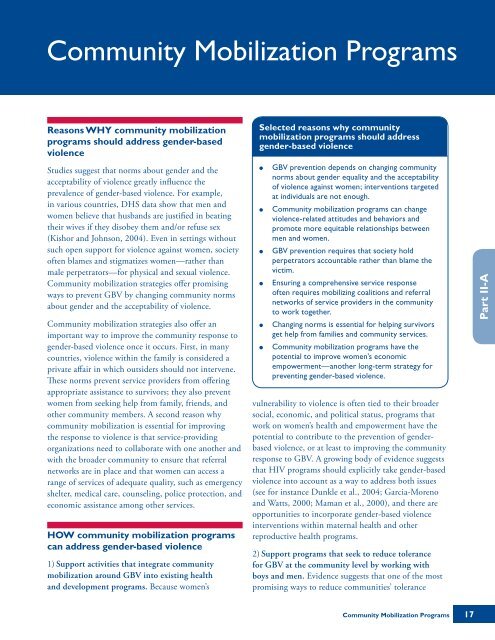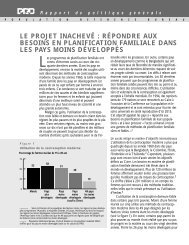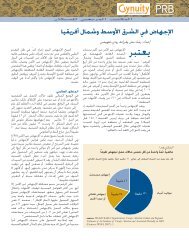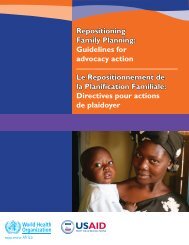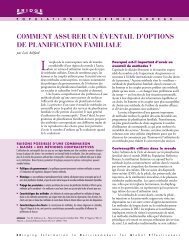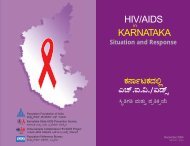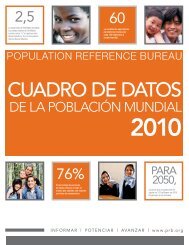addressing gender-based violence through usaid's health ... - IGWG
addressing gender-based violence through usaid's health ... - IGWG
addressing gender-based violence through usaid's health ... - IGWG
You also want an ePaper? Increase the reach of your titles
YUMPU automatically turns print PDFs into web optimized ePapers that Google loves.
Community Mobilization Programs<br />
Reasons WHY community mobilization<br />
programs should address <strong>gender</strong>-<strong>based</strong><br />
<strong>violence</strong><br />
Studies suggest that norms about <strong>gender</strong> and the<br />
acceptability of <strong>violence</strong> greatly influence the<br />
prevalence of <strong>gender</strong>-<strong>based</strong> <strong>violence</strong>. For example,<br />
in various countries, DHS data show that men and<br />
women believe that husbands are justified in beating<br />
their wives if they disobey them and/or refuse sex<br />
(Kishor and Johnson, 2004). Even in settings without<br />
such open support for <strong>violence</strong> against women, society<br />
often blames and stigmatizes women—rather than<br />
male perpetrators—for physical and sexual <strong>violence</strong>.<br />
Community mobilization strategies offer promising<br />
ways to prevent GBV by changing community norms<br />
about <strong>gender</strong> and the acceptability of <strong>violence</strong>.<br />
Community mobilization strategies also offer an<br />
important way to improve the community response to<br />
<strong>gender</strong>-<strong>based</strong> <strong>violence</strong> once it occurs. First, in many<br />
countries, <strong>violence</strong> within the family is considered a<br />
private affair in which outsiders should not intervene.<br />
These norms prevent service providers from offering<br />
appropriate assistance to survivors; they also prevent<br />
women from seeking help from family, friends, and<br />
other community members. A second reason why<br />
community mobilization is essential for improving<br />
the response to <strong>violence</strong> is that service-providing<br />
organizations need to collaborate with one another and<br />
with the broader community to ensure that referral<br />
networks are in place and that women can access a<br />
range of services of adequate quality, such as emergency<br />
shelter, medical care, counseling, police protection, and<br />
economic assistance among other services.<br />
HOW community mobilization programs<br />
can address <strong>gender</strong>-<strong>based</strong> <strong>violence</strong><br />
1) Support activities that integrate community<br />
mobilization around GBV into existing <strong>health</strong><br />
and development programs. Because women’s<br />
Selected reasons why community<br />
mobilization programs should address<br />
<strong>gender</strong>-<strong>based</strong> <strong>violence</strong><br />
●<br />
●<br />
●<br />
●<br />
●<br />
●<br />
GBV prevention depends on changing community<br />
norms about <strong>gender</strong> equality and the acceptability<br />
of <strong>violence</strong> against women; interventions targeted<br />
at individuals are not enough.<br />
Community mobilization programs can change<br />
<strong>violence</strong>-related attitudes and behaviors and<br />
promote more equitable relationships between<br />
men and women.<br />
GBV prevention requires that society hold<br />
perpetrators accountable rather than blame the<br />
victim.<br />
Ensuring a comprehensive service response<br />
often requires mobilizing coalitions and referral<br />
networks of service providers in the community<br />
to work together.<br />
Changing norms is essential for helping survivors<br />
get help from families and community services.<br />
Community mobilization programs have the<br />
potential to improve women’s economic<br />
empowerment—another long-term strategy for<br />
preventing <strong>gender</strong>-<strong>based</strong> <strong>violence</strong>.<br />
vulnerability to <strong>violence</strong> is often tied to their broader<br />
social, economic, and political status, programs that<br />
work on women’s <strong>health</strong> and empowerment have the<br />
potential to contribute to the prevention of <strong>gender</strong><strong>based</strong><br />
<strong>violence</strong>, or at least to improving the community<br />
response to GBV. A growing body of evidence suggests<br />
that HIV programs should explicitly take <strong>gender</strong>-<strong>based</strong><br />
<strong>violence</strong> into account as a way to address both issues<br />
(see for instance Dunkle et al., 2004; Garcia-Moreno<br />
and Watts, 2000; Maman et al., 2000), and there are<br />
opportunities to incorporate <strong>gender</strong>-<strong>based</strong> <strong>violence</strong><br />
interventions within maternal <strong>health</strong> and other<br />
reproductive <strong>health</strong> programs.<br />
2) Support programs that seek to reduce tolerance<br />
for GBV at the community level by working with<br />
boys and men. Evidence suggests that one of the most<br />
promising ways to reduce communities’ tolerance<br />
Part II-A<br />
Community Mobilization Programs<br />
17


